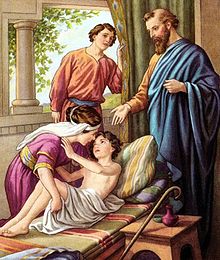ইলীশায়
ইলীশায়
| |
|---|---|
 ইলীশায় শূনেমীয়ার মৃত পুত্রকে জাগিয়ে তুললেন, আদি ১৯০০ দশকের বাইবেল কার্ড চিত্রালঙ্কার | |
| ভাববাদী | |
| জন্ম | আনু. ৮৮৫ খ্রী.পূ. আবেল-মহোলা, ইস্রায়েল রাজ্য |
| বাসস্থান | ইস্রায়েল রাজ্য |
| মৃত্যু | আনু. ৭৯০ খ্রী.পূ. শমরিয়া, ইস্রায়েল রাজ্য |
| শ্রদ্ধাজ্ঞাপন | |
| উৎসব | ১৭ জুন |
| যার দ্বারা প্রভাবিত | এলিয় |
ঐতিহ্য বা ধরন | যিহূদীয়-খ্রীষ্টীয়, ইসলামি, দ্রুজ, বাহাই |
ইলীশায়[২] (হিব্রু ভাষায়: אֱלִישָׁע, ʾĔlīšāʿ; প্রাচীন গ্রিক: Ἐλισ[σ]αῖος, Elis[s]aîos বা Ἐλισαιέ, Elisaié; আরবি: اليسع, প্রতিবর্ণীকৃত: Alyasāʿ) ছিলেন হিব্রু বাইবেল অনুসারে একজন ভাববাদী ও অলৌকিক সাধক। নূতন নিয়ম[৩] ও কুরআনেও[৬:৮৬][৩৮:৪৮] উদ্ধৃত ইলীশায়কে ইহুদিধর্ম, খ্রিস্টধর্ম, ইসলাম, দ্রুজ ও বাহাই ধর্মে একজন নবী হিসেবে শ্রদ্ধা করা হয়।[৪]
বাইবেলীয় বর্ণনায় তিনি এলিয়ের একজন শিষ্য ও আশ্রিত ব্যক্তি। এলিয় ঘূর্ণবায়ুতে স্বর্গারোহণের পর ইলীশায়কে তাঁর ক্ষমতার দ্বিগুণ অংশ দিয়েছিলেন এবং ইলীশায় নবীদের পুত্রদের নেতা হিসাবে গৃহীত হয়েছিলেন। ইলীশায় তখন এলিয়ের চেয়ে দ্বিগুণ অলৌকিক কাজ করতে শুরু করেন।
শমরিয়াতে বসতি স্থাপনের আগে ইলীশায় কর্মিল পর্বতে কিছু সময় অতিবাহিত করেছিলেন। তিনি ইস্রায়েল দেশে সুপরিচিত হয়ে উঠেছিলেন এবং ছয় দশক ধরে (৮৯২–-৮৩২ খ্রীষ্টপূর্ব) “ইস্রায়েলের ভাববাদী” পদে অধিষ্ঠিত ছিলেন। সৈন্য ও রাজাদের সাহায্য করার কারণে তাকে দেশপ্রেমিক বলা হয়।[৫]
তথ্যসূত্র
[সম্পাদনা]- ↑ Swayd, Samy (২০১৫)। Historical Dictionary of the Druzes। Rowman & Littlefield। পৃষ্ঠা 77। আইএসবিএন 9781442246171।
- ↑ Wells, John C. (১৯৯০)। "Elisha"। Longman Pronunciation Dictionary। Harlow, England: Longman। পৃষ্ঠা 239। আইএসবিএন 0-582-05383-8।
- ↑ লূক ৪:২৭ "And there were many lepers in Israel in the time of Elisha the prophet. Yet not one of them was cleansed--only Naaman the Syrian."
- ↑ Revisioning the Sacred: New Perspectives on a Bahái̓́ Theology, Volume 8. p. 32. Jack McLean. 1997.
- ↑ উদ্ধৃতি ত্রুটি:
<ref>ট্যাগ বৈধ নয়;autogenerated1996নামের সূত্রটির জন্য কোন লেখা প্রদান করা হয়নি
অধিকতর পাঠ্য
[সম্পাদনা]ইসলামি দৃষ্টিকোণ
[সম্পাদনা]- Amina Adil, Gaben des Lichts. Die wundersamen Geschichten der Gesandten Gottes (Kandern im Schwarzwald 1999), 563–73
- al-Farrāʾ, Maʿānī al-Qurʾān, ed. Aḥmad Yūsuf Najātī and Muḥammad ʿAlī al-Najjār (Cairo 1955–71), 2:407–8
- Josef Horovitz, Koranische Untersuchungen (Berlin and Leipzig 1926), 99, 101
- al-Khūshābī, ʿArāʾis al-Qurʾān wa-nafāʾis al-furqān wa-farādīs al-jinān, ed. Saʿīd ʿAbd al-Fattāḥ (Beirut 2007), 167–9
- al-Kisāʾī, Qiṣaṣ al-anbiyāʾ, ed. Isaac Eisenberg (Leiden 1922–3), 199–205, trans. Wheeler M. Thackston Jr., The tales of the prophets of al-Kisaʾi (Boston 1978), 269
- al-Majlisī, Biḥār al-anwār (Beirut 1983), 13:396–403
- al-Maqdisī, al-Muṭahhar b. Ṭāhir, al-Badʾ wa-l-taʾrīkh, ed. Clément Huart (Paris 1903), 3:100
- al-Rabghūzī, Stories of the prophets, ed. Hendrik E. Boeschoten, M. Vandamme, and Semih Tezcan (Leiden 1995), 2:460
- Sibṭ b. al-Jawzī, Mirʾāt al-zamān fī taʾrīkh al-aʿyān, ed. Iḥsān ʿAbbās (Beirut 1985), 1:460, 466
- al-Ṭabarī, Taʾrīkh al-rusul wa-l-mulūk, ed. M. J. de Goeje et al. (Leiden 1879–1901), 1:542–4, trans. William M. Brinner, The history of al-Ṭabarī, vol. 4, The Children of Israel (Albany 1991), 124–5
- al-Thaʿlabī, Qiṣaṣ al-anbiyāʾ (Cairo 1954), 259–61, trans. William M. Brinner, ʿArāʾis al-Majālis fī Qiṣaṣ al-Anbiyāʾ or Lives of the prophets, as recounted by Abū Isḥāq Aḥmad ibn Muḥammad ibn Ibrāhīm al-Thaʿlabī (Leiden 2002), 432–35.
বহিঃসংযোগ
[সম্পাদনা]- Prophet Elisha in Carmelite Tradition ওয়েব্যাক মেশিনে আর্কাইভকৃত ১৫ ফেব্রুয়ারি ২০১৫ তারিখে
- Prophet Elisha Orthodox icon and synaxarion
